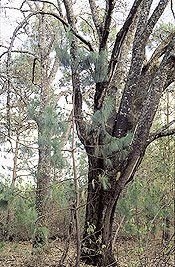Scientific Name: Quercus hintonii
Categories: Timber, endangered
Conservation Status: Critically endangered
Introduction

A deciduous small tree that grows up to 15 m in height and occurs in sub-montane to montane dry forest in Mexico. It has a dark bark and is characterized by bright red foliage in early spring.
Why is this species important?

This species represents one of the Quercus species considered of great importance in Mexico. Habitat of Q. hintonii has been seriously destroyed and reduced, undermining the viability of the species. Q. hintonii wood has a variety of local uses, being part of the traditional culture of Tejupilco people.
Where is it found?
Q. hintonii is endemic to Mexico, occurring in the south-east of Mexico State between 1300 and 2000 m. A recent study by the Sir Harold Hillier Gardens and Arboretum together with the University of Puebla has determined that this species covers just 46 000 hectares, distributed across three highly disturbed populations.
How do people use it?
Q. hintonii wood is used locally for tool handles, beams and fencing poles, but primarily for firewood. The wood is traditionally used to bake "las finas" bread, the characteristic taste of which is imparted by the smoke.
Why is it threatened?
The populations of Q. hintonii have been dramatically reduced as a result of habitat loss to the point where the species is considered in danger of extinction. Agriculture (maize and fruit trees), coffee plantation and road construction have all contributed to the decline in populations. The species has also been highly affected by grazing, which prevents regeneration.
What conservation action is needed?
The recent study as part of the Global Trees Campaign revealed that the current status of Q. hintonii population is strongly associated with the development and economic activities of the local communities. Conservation measures include the involvement of local authorities and landowners, training on plant propagation, field research, and the development of an education campaign.Collaborative research between Mexican experts from the University of Puebla and staff from the Sir Harold Hillier Gardens & Arboretum in the UK has led to the development of a conservation strategy for Quercus hintonii, which was presented to the Regional Education Co-ordinator, the presidents of municipalities and the authorities in charge of reforestation. In addition, an educational guide to the conservation of the species has been produced and an agreement has been reached to provide local training in oak propagation techniques.
longchamp outlet, nike outlet, michael kors outlet online, chanel handbags, christian louboutin outlet, ray ban sunglasses, tiffany and co, replica watches, coach outlet, tiffany jewelry, michael kors outlet online, nike air max, polo ralph lauren outlet online, michael kors outlet store, oakley sunglasses, polo outlet, christian louboutin uk, christian louboutin, burberry handbags, longchamp outlet, kate spade outlet, prada handbags, michael kors outlet, gucci handbags, michael kors outlet, coach outlet, prada outlet, kate spade, michael kors outlet online, tory burch outlet, christian louboutin shoes, coach outlet store online, burberry outlet, true religion outlet, nike air max, coach purses, oakley sunglasses, jordan shoes, longchamp outlet, ray ban sunglasses, oakley sunglasses wholesale, nike free
ReplyDeletenorth face, nike air max uk, sac hermes, hollister uk, nike air force, louboutin pas cher, michael kors, oakley pas cher, converse pas cher, abercrombie and fitch uk, hollister pas cher, nike free run, jordan pas cher, nike tn, burberry pas cher, longchamp pas cher, timberland pas cher, nike air max, polo ralph lauren, nike roshe, lululemon canada, ralph lauren uk, true religion outlet, guess pas cher, vans pas cher, sac longchamp pas cher, nike air max uk, true religion jeans, hogan outlet, north face uk, new balance, air max, ray ban pas cher, nike free uk, true religion outlet, nike blazer pas cher, sac vanessa bruno, michael kors pas cher, ray ban uk, polo lacoste, michael kors outlet, mulberry uk
ReplyDeletehollister clothing, giuseppe zanotti outlet, lululemon, wedding dresses, abercrombie and fitch, hermes belt, asics running shoes, bottega veneta, celine handbags, soccer shoes, valentino shoes, ferragamo shoes, vans outlet, mcm handbags, timberland boots, nike roshe run uk, longchamp uk, nike air max, north face outlet, p90x workout, new balance shoes, insanity workout, iphone 6 cases, herve leger, instyler, oakley, hollister, nike huaraches, soccer jerseys, nike trainers uk, babyliss, chi flat iron, ghd hair, baseball bats, jimmy choo outlet, mont blanc pens, north face outlet, mac cosmetics, beats by dre, nfl jerseys, reebok outlet, nike roshe run
ReplyDeleteralph lauren, vans, gucci, pandora jewelry, ray ban, hollister, ugg, swarovski crystal, links of london, lancel, toms shoes, juicy couture outlet, montre pas cher, pandora uk, replica watches, converse outlet, ugg,ugg australia,ugg italia, coach outlet, ugg uk, hollister, ugg pas cher, uggs outlet, ugg boots, supra shoes, pandora charms, marc jacobs, louboutin, thomas sabo, juicy couture outlet, ugg boots, karen millen uk, uggs outlet, converse, swarovski, uggs on sale, nike air max, ugg,uggs,uggs canada, wedding dresses
ReplyDeletebape outlet
ReplyDeletenike sb dunks
golden goose outlet
kobe byrant shoes
jordan outlet
chrome hearts outlet